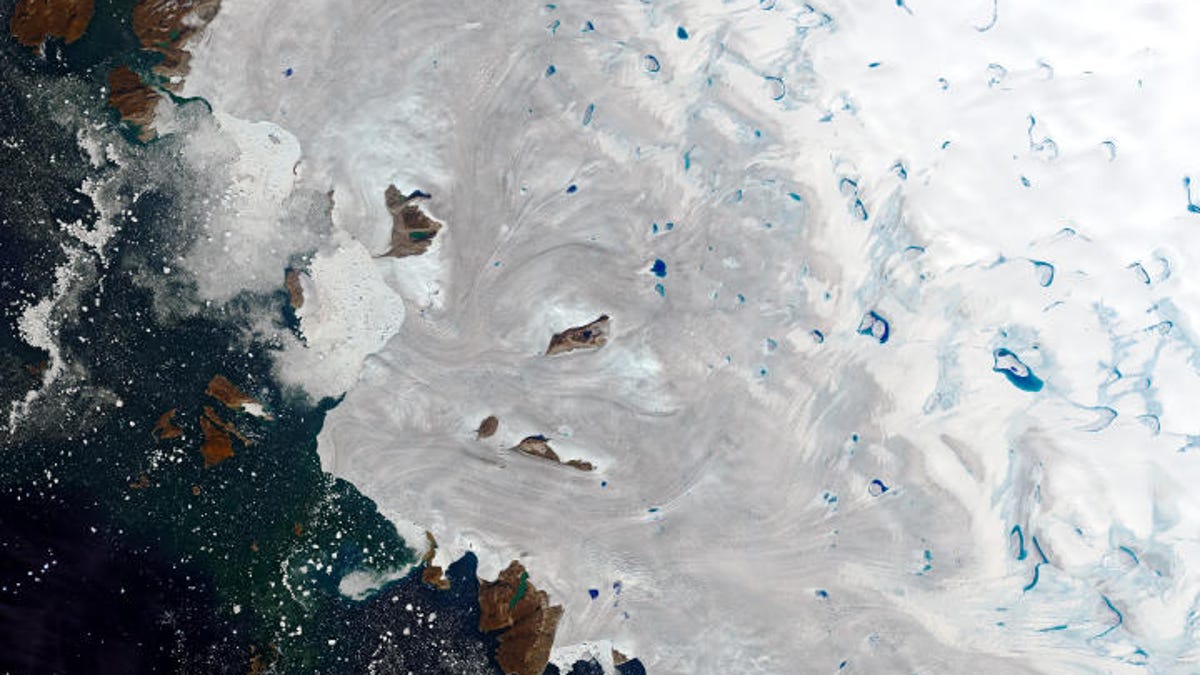Greenland is melting and it even looks bad from space
NASA satellite images tell a sobering story of the impact of extreme weather on Greenland's ice.

This satellite view of Greenland shows bright blue melt ponds.
Europe is cooking. Siberia is on fire. Greenland is melting. Welcome to the new world; it's hotter than the old one.
Climate scientist and glaciologist Ruth Mottram of the Danish Meteorological Institute took to Twitter on Thursday to share the sobering news that Greenland lost 11 gigatons of ice in a single day on Aug. 1.
The #Greenland #icesheet starts August as it ended July - 11 Gigatonnes lost on 1st: highest daily total of the #melt season so far
— Ruth Mottram (@ruth_mottram) August 2, 2019
Melt season should ramp down over the month but forecast shows warm period continuing next few dayshttps://t.co/R2dc4Kkjgl pic.twitter.com/D1g7gD1kVx
A gigaton is a billion metric tons. "A single gigaton of water would fill about 400,000 Olympic-sized swimming pools," NASA said in an ice explainer in 2018.
NASA satellites have been watching the hot weather unfold and take a toll on Greenland's ice sheet in July. "Billions of tons of meltwater streamed into the Atlantic Ocean throughout the month, making a direct and immediate contribution to sea level rise," the agency said in a release on Friday.
This NASA Landsat 8 image shows a meltwater pond near the edge of Greenland's ice sheet.
An image captured by the Landsat 8 satellite shows how the meltwater is creating ponds near the edge of the ice sheet.
"Summer melting along the periphery is typical," said NASA. "In contrast, a melt area that totals nearly 1 million square kilometers of the ice sheet, as it did on July 30-31, is less common."
The view from ground level is also sobering. Writer Laurie Garrett shared a video Thursday showing glacial meltwater roaring under a bridge in Greenland.
This is a roaring glacial melt, under the bridge to Kangerlussiauq, Greenland where it's 22C today and Danish officials say 12 billions tons of ice melted in 24 hours, yesterday. pic.twitter.com/Rl2odG4xWj
— Laurie Garrett (@Laurie_Garrett) August 1, 2019
We already had a clue back in June that 2019 would be a brutal year for Greenland. A climate researcher shared an image of water that had melted off from a layer of sea ice near an Arctic village. That photo went viral.
Extreme weather is becoming the new normal for our planet as the world grapples with the impact of human-caused climate change. With it comes wildfires, seaweed infestations, heat waves and ice melt.
Greenland's last major melt event happened in 2012. It may not take seven years to reach the next one.

